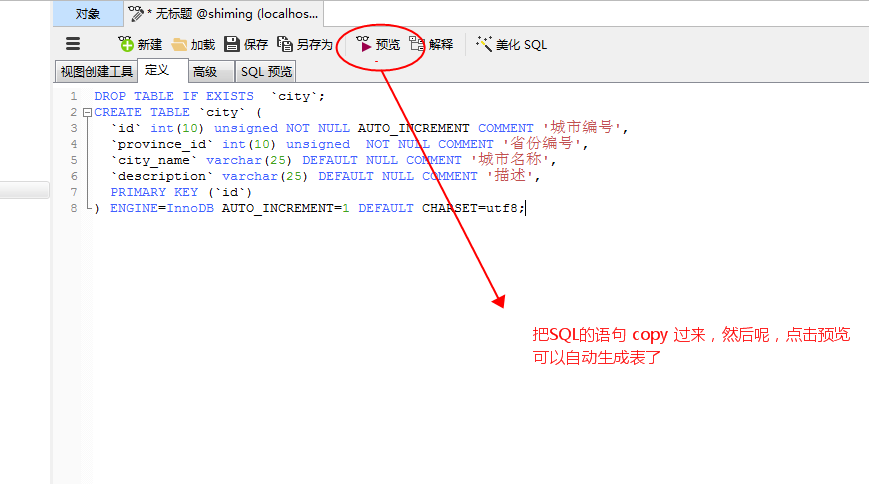- 首先推荐一个好玩的网站 ASCll ,可以把你想要的字母生成文本的图形,然后
copy到banner.txt,即可替换Spring Boot的开启图标
88 88
88 88
88 88
88 88 ,adPPYba, 8b d8 ,adPPYba, 88 88
88 88 a8" "8a `8b d8' a8P_____88 88 88
88 88 8b d8 `8b d8' 8PP""""""" 88 88
88 88 "8a, ,a8" `8b,d8' "8b, ,aa "8a, ,a88
88 88 `"YbbdP"' "8" `"Ybbd8"' `"YbbdP'Y8
88 88 88
88 "" ""
88
,adPPYba, 88,dPPYba, 88 88,dPYba,,adPYba, 88 8b,dPPYba, ,adPPYb,d8
I8[ "" 88P' "8a 88 88P' "88" "8a 88 88P' `"8a a8" `Y88
`"Y8ba, 88 88 88 88 88 88 88 88 88 8b 88
aa ]8I 88 88 88 88 88 88 88 88 88 "8a, ,d88
`"YbbdP"' 88 88 88 88 88 88 88 88 88 `"YbbdP"Y8
aa, ,88
"Y8bbdP"
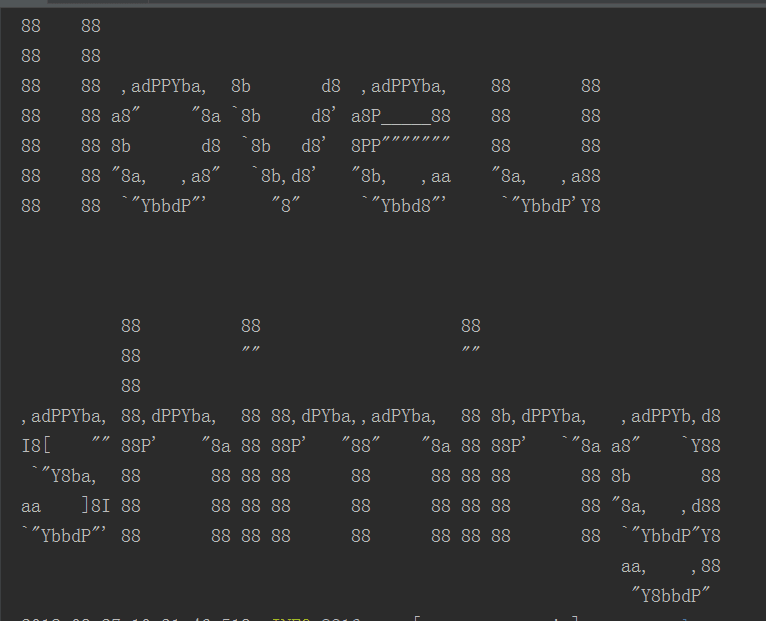
Swagger2
Swagger是一款可以快速生成符合RESTful风格API并进行在线调试的插件。REST实际上为Representational State Transfer的缩写,翻译为“表现层状态转化” 。如果一个架构符合REST原则,就称它为RESTful架构。 实际上,“表现层状态转化”省略了主语,完整的说应该是“资源表现层状态转化”。什么是资源Resource?资源指的是网络中信息的表现形式,比如一段文本,一首歌,一个视频文件等等;什么是表现层Reresentational?表现层即资源的展现在你面前的形式,比如文本可以是JSON格式的,也可以是XML形式的,甚至为二进制形式的。图片可以是gif,也可以是PNG;什么是状态转换State Transfer?用户可使用URL通过HTTP协议来获取各种资源,HTTP协议包含了一些操作资源的方法,比如:GET 用来获取资源, POST 用来新建资源 , PUT用来更新资源,DELETE 用来删除资源,PATCH 用来更新资源的部分属性。通过这些HTTP协议的方法来操作资源的过程即为状态转换。
- 传统
URL请求和RESTful风格请求的区别
描述 传统请求 方法 RESTful请求 方法
查询 /user/query?name=mrbird GET /user?name=mrbird GET
详情 /user/getInfo?id=1 GET /user/1 GET
创建 /user/create?name=mrbird POST /user POST
修改 /user/update?name=mrbird&id=1 POST /user/1 PUT
删除 /user/delete?id=1 GET /user/1 DELETE
大致可以总结下传统请求和RESTful请求的几个区别:
- 传统请求通过URL来描述行为,如
create,delete等;RESTful请求通过URL来描述资源。 RESTful请求通过HTTP请求的方法来描述行为,比如DELETE,POST,PUT等,并且使用HTTP状态码来表示不同的结果。RESTful请求通过JSON来交换数据。
一、引入Swagger、MySQL 依赖
<!-- MySQL 连接驱动依赖 -->
<dependency>
<groupId>mysql</groupId>
<artifactId>mysql-connector-java</artifactId>
<version>${mysql-connector}</version>
</dependency>
<!-- Spring Boot Mybatis 依赖 -->
<dependency>
<groupId>org.mybatis.spring.boot</groupId>
<artifactId>mybatis-spring-boot-starter</artifactId>
<version>${mybatis-spring-boot}</version>
</dependency>
<!--使用的Swagger版本为2.6.1:-->
<dependency>
<groupId>io.springfox</groupId>
<artifactId>springfox-swagger2</artifactId>
<version>2.6.1</version>
</dependency>
<!--ui的界面-->
<dependency>
<groupId>io.springfox</groupId>
<artifactId>springfox-swagger-ui</artifactId>
<version>2.6.1</version>
</dependency>
二、配置 SwaggerConfig
/**
* author: Created by shiming on 2018/9/26 18:10
* mailbox:lamshiming@sina.com
*/
@Configuration
@EnableSwagger2
public class SwaggerConfig {
// 在配置类中添加@EnableSwagger2注解来启用Swagger2,apis()定义了扫描的包路径
@Bean
public Docket buildDocket() {
return new Docket(DocumentationType.SWAGGER_2)
.apiInfo(buildApiInf())
.select()
.apis(RequestHandlerSelectors.basePackage("com.example.swagger.web"))
.paths(PathSelectors.any())
.build();
}
private ApiInfo buildApiInf() {
return new ApiInfoBuilder()
.title("RESTful API 文档")
.contact(new Contact("shiming", "https://www.shiming.site/", null))
.version("1.0")
.build();
}
}
三、配置数据库,创建表
## 数据源配置
spring.datasource.url= jdbc:mysql://localhost:3306/shiming?useUnicode=true&characterEncoding=utf-8&useSSL=true
spring.datasource.username=root
spring.datasource.password=App123
spring.datasource.driver-class-name=com.mysql.jdbc.Driver
-
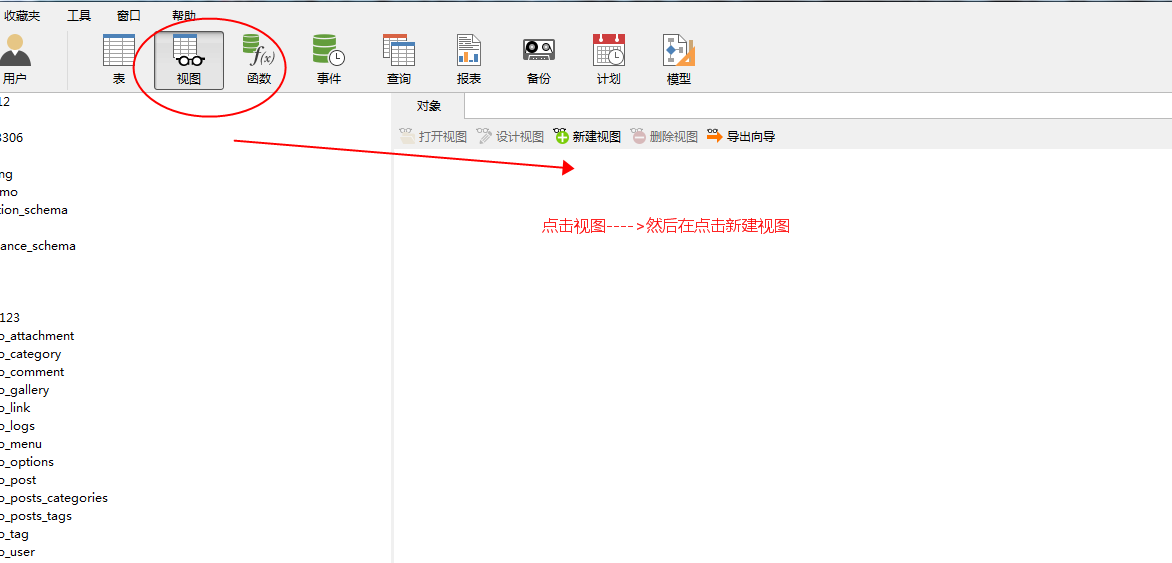
-
创建数据库
DROP TABLE IF EXISTS `user`;
CREATE TABLE `user` (
`id` int(10) unsigned NOT NULL AUTO_INCREMENT COMMENT 'id',
`user_name` varchar(25) DEFAULT NULL COMMENT '用户姓名',
`user_age` varchar(25) DEFAULT NULL COMMENT '用户年级',
`description` varchar(25) DEFAULT NULL COMMENT '用户描述',
PRIMARY KEY (`id`)
) ENGINE=InnoDB AUTO_INCREMENT=1 DEFAULT CHARSET=utf8;
INSERT user VALUES (0,'仕明','25','仕明是个好同学');
-
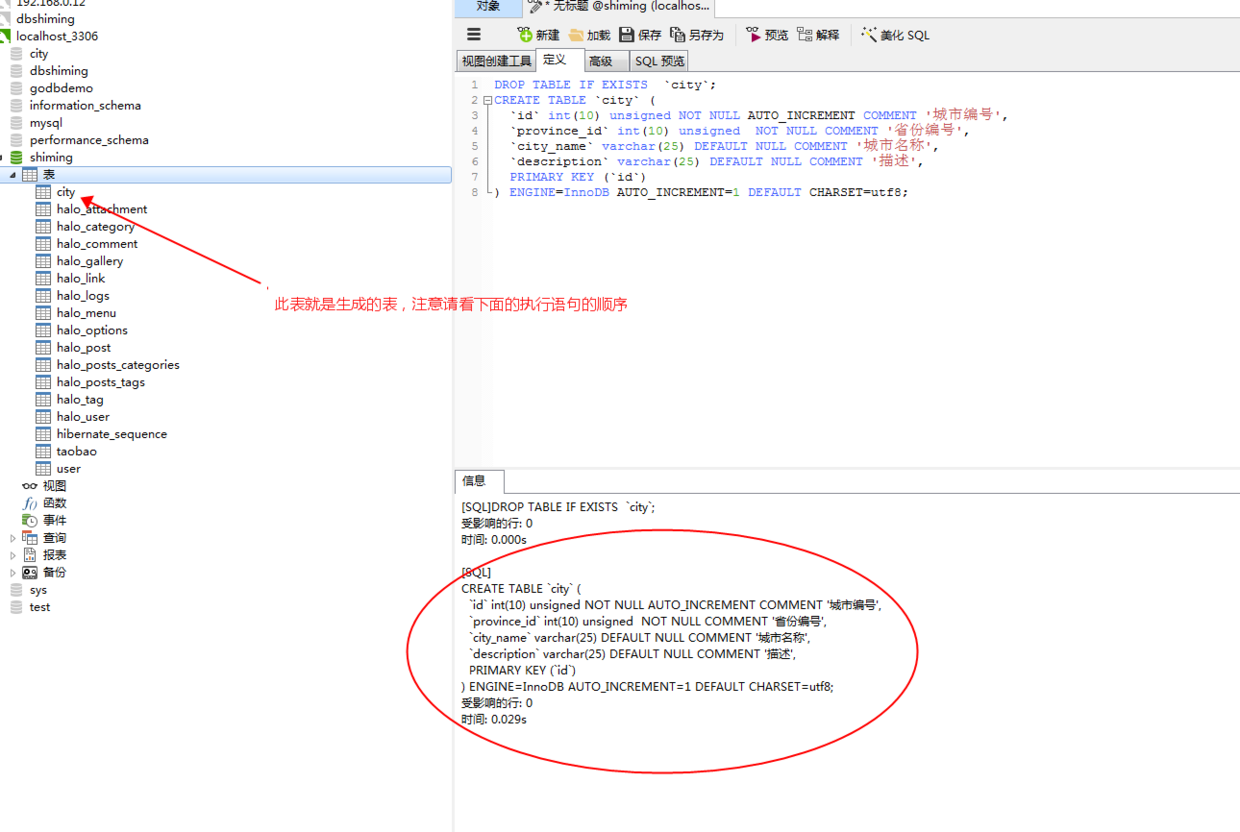
-
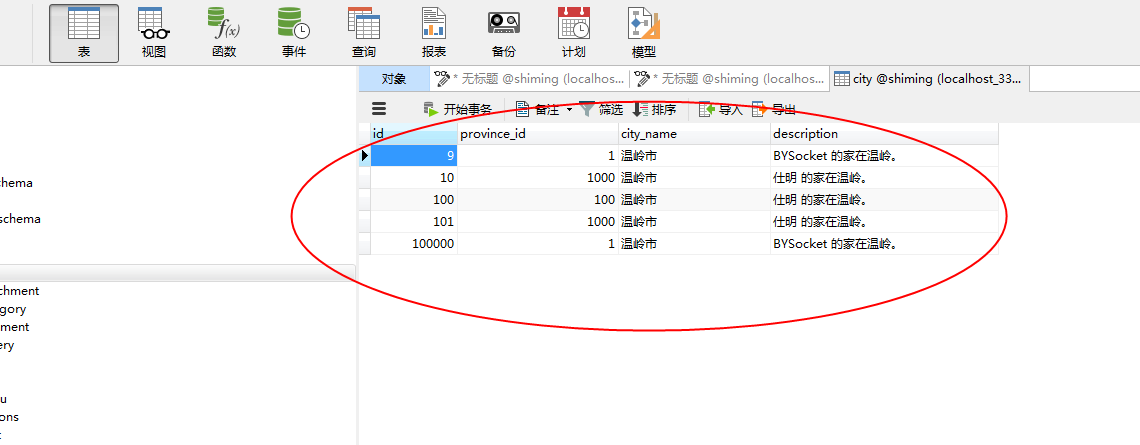
-
最终的创建的表

-
访问本地地址 :http://localhost:8080/swagger-ui.html#/
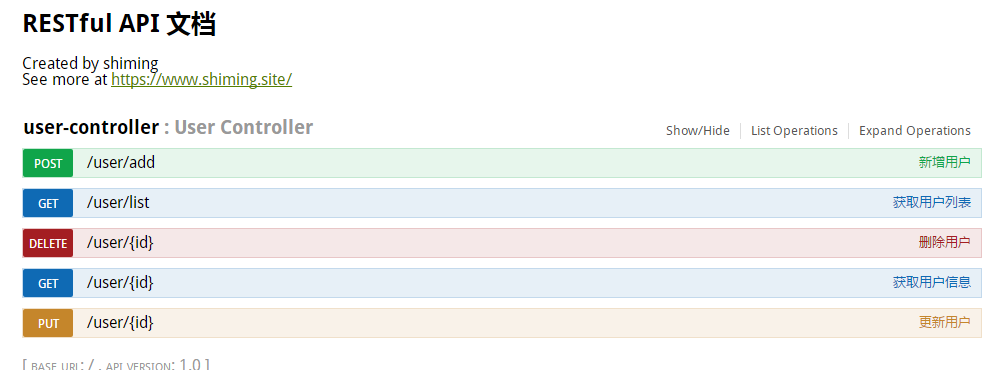
四、测试
-
使用
swagger新增用户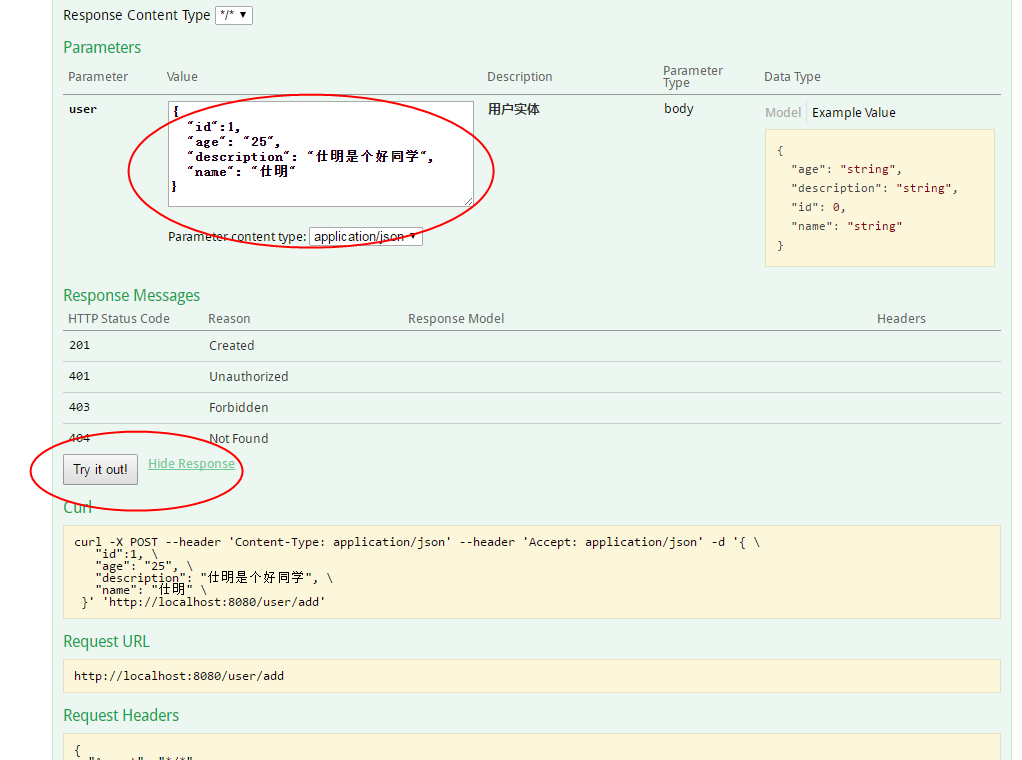
-
使用
swagger获取用户列表,也可以访问:http://localhost:8080/user/list
{
"code": "0",
"message": "success",
"result": [
{
"id": 1,
"name": "仕明",
"age": "25",
"description": "仕明是个好同学"
},
{
"id": 2,
"name": "仕明",
"age": "25",
"description": "仕明是个好同学"
},
{
"id": 3,
"name": "仕明",
"age": "25",
"description": "仕明是个好同学"
},
{
"id": 4,
"name": "仕明",
"age": "25",
"description": "仕明是个好同学"
},
{
"id": 5,
"name": "仕明",
"age": "25",
"description": "仕明是个好同学"
},
{
"id": 6,
"name": "仕明",
"age": "25",
"description": "仕明是个好同学"
},
{
"id": 7,
"name": "仕明",
"age": "25",
"description": "仕明是个好同学"
}
]
}
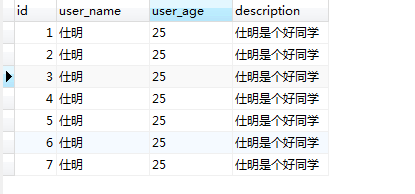
-
使用
swagger删除id=1的用户!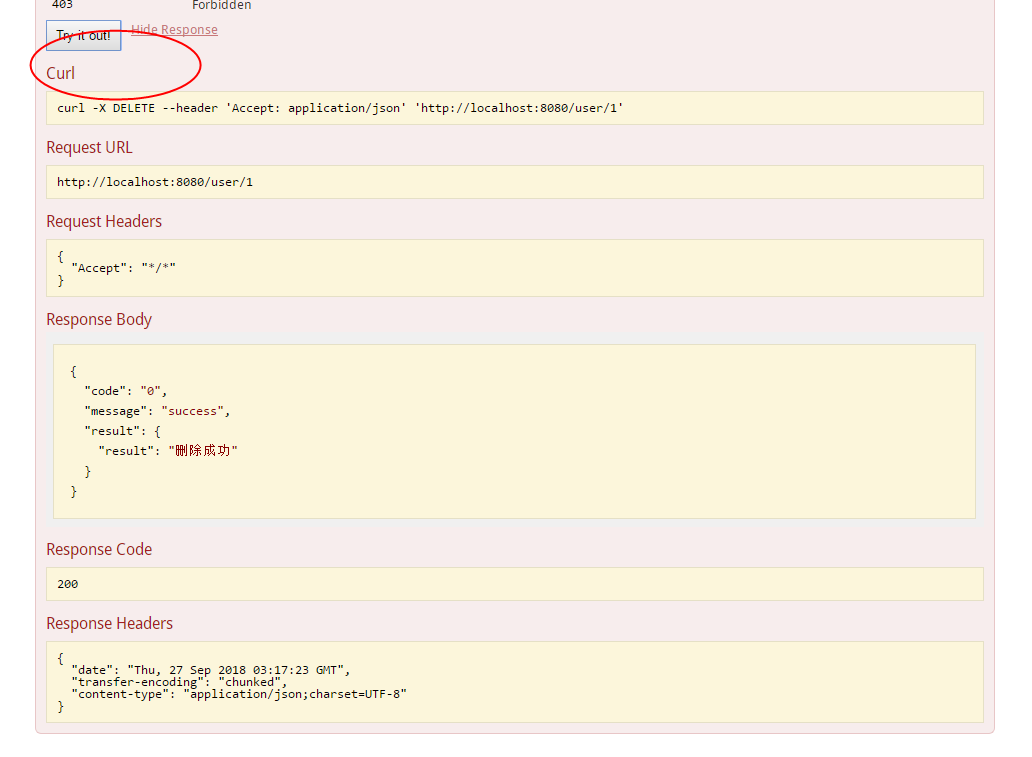
-
使用
swagger获取id=2的用户!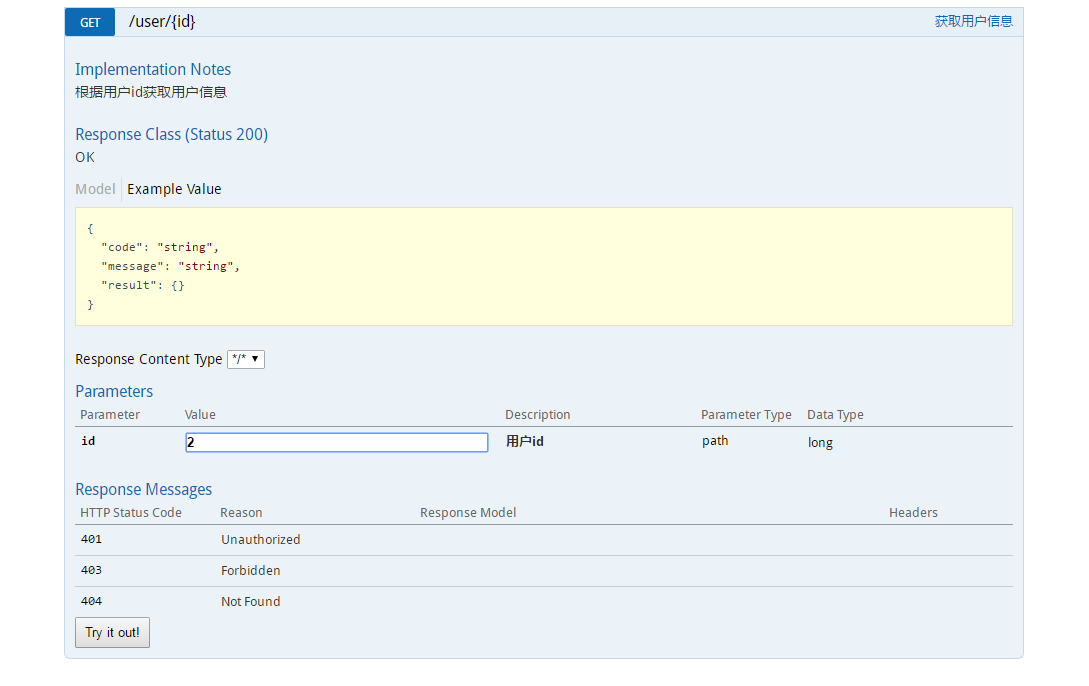
{
"code": "0",
"message": "success",
"result": {
"id": 2,
"name": "仕明",
"age": "25",
"description": "仕明是个好同学"
}
}
- 使用
swagger更新用户!
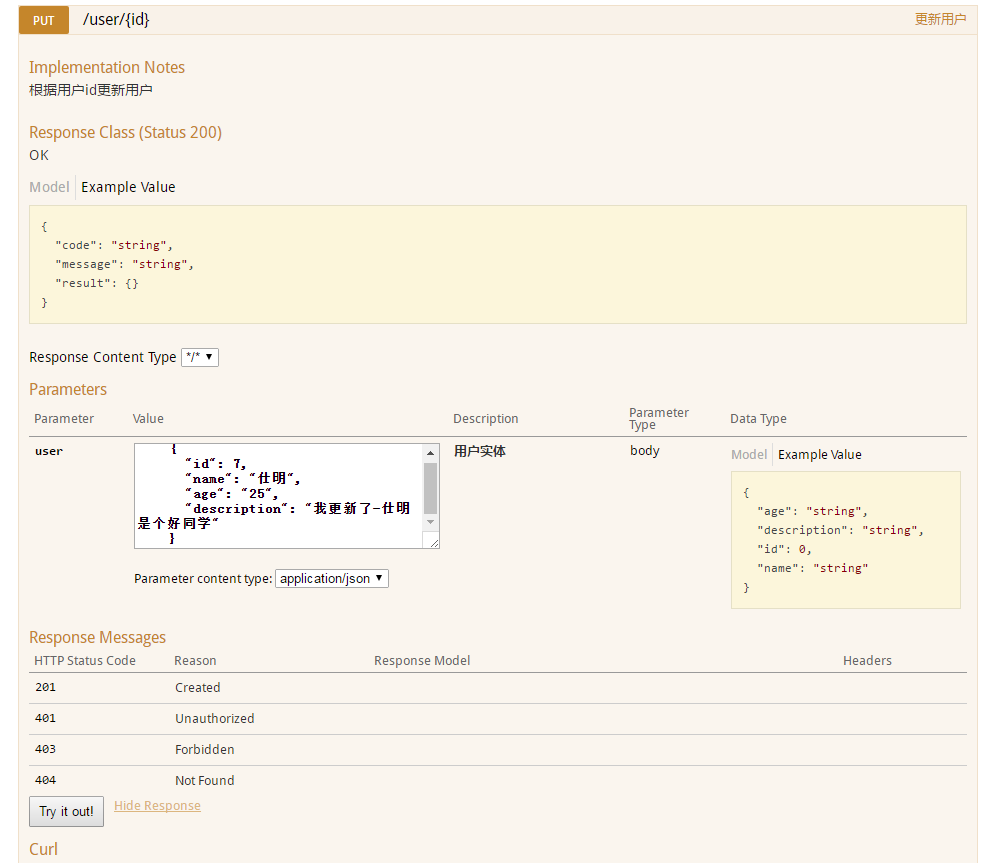
{
"id": 7,
"name": "仕明",
"age": "25",
"description": "我更新了-仕明是个好同学"
}
-
更新后的数据库
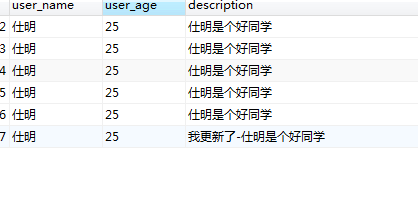
-
UserController的代码如下
/**
* author: Created by shiming on 2018/9/26 16:42
* mailbox:lamshiming@sina.com
*/
@Api(value = "用户Controller")
@Controller
@RequestMapping(value = "/user")
public class UserController {
@Autowired
UserService cityService;
//{"id":1,"name":"仕明","age":"25","description":"仕明是个好同学"}
// http://localhost:8080/user/1
@ApiOperation(value = "获取用户信息", notes = "根据用户id获取用户信息")
@ApiImplicitParam(name = "id", value = "用户id", required = true, dataType = "Long", paramType = "path")
@GetMapping("/{id}")
@ResponseBody
public ResultBody getUserById(@PathVariable(value = "id") Long id) throws GlobalErrorInfoException {
System.out.println("id="+id);
User userById = cityService.getUserById(id);
if(userById!=null){
ResultBody resultBody = new ResultBody(userById);
return resultBody;
}
// User user = new User();
// user.setDescription("没有找到这个人");
throw new GlobalErrorInfoException(GlobalErrorInfoEnum.NOT_FOUND);
// return user;
}
// http://localhost:8080/user/list
@ApiOperation(value = "获取用户列表", notes = "获取用户列表")
@GetMapping("/list")
@ResponseBody
public ResultBody getUserList() throws GlobalErrorInfoException {
List<User> userList = cityService.getUserList();
if (userList==null||userList.size()==0){
throw new GlobalErrorInfoException(GlobalErrorInfoEnum.NOT_FOUND);
}
ResultBody resultBody = new ResultBody(userList);
return resultBody;
}
@ApiOperation(value = "新增用户", notes = "根据用户实体创建用户")
@ApiImplicitParam(name = "user", value = "用户实体", required = true, dataType = "User")
@PostMapping("/add")
@ResponseBody
public ResultBody addUser(@RequestBody User user) {
Long aLong = cityService.addUser(user);
System.out.println("Long=="+aLong);
Map<String, Object> map = new HashMap<>();
map.put("result", "新增用户成功");
ResultBody resultBody = new ResultBody(map);
return resultBody;
}
@ApiOperation(value = "删除用户", notes = "根据用户id删除用户")
@ApiImplicitParam(name = "id", value = "用户id", required = true, dataType = "Long", paramType = "path")
@DeleteMapping("/{id}")
@ResponseBody
public ResultBody deleteUser(@PathVariable(value = "id") Long id) {
Long aLong = cityService.deleteUser(id);
System.out.println("along="+aLong);
System.out.println("删除掉的id="+id);
Map<String, Object> map = new HashMap<>();
map.put("result", "删除成功");
ResultBody resultBody = new ResultBody(map);
return resultBody;
}
@ApiOperation(value = "更新用户", notes = "根据用户id更新用户")
@ApiImplicitParams(@ApiImplicitParam(name = "user", value = "用户实体", required = true, dataType = "User"))
@PutMapping("/{id}")
@ResponseBody
public ResultBody updateUser(@RequestBody User user) {
System.out.println(user.toString());
Long aLong = cityService.updateUser(user);
System.out.println("aLong="+aLong);
Map<String, Object> map = new HashMap<>();
map.put("result", "更新成功");
ResultBody resultBody = new ResultBody(map);
return resultBody;
}
}
Swagger常用注解
-
@Api:修饰整个类,描述Controller的作用;
-
@ApiOperation:描述一个类的一个方法,或者说一个接口;
-
@ApiParam:单个参数描述;
-
@ApiModel:用对象来接收参数;
-
@ApiProperty:用对象接收参数时,描述对象的一个字段;
-
@ApiResponse:HTTP响应其中1个描述;
-
@ApiResponses:HTTP响应整体描述;
-
@ApiIgnore:使用该注解忽略这个API;
-
@ApiError :发生错误返回的信息;
-
@ApiImplicitParam:一个请求参数;
-
@ApiImplicitParams:多个请求参数。
-
编写RESTful API接口
- Spring Boot中包含了一些注解,对应于HTTP协议中的方法:
- @GetMapping对应HTTP中的GET方法;
- @PostMapping对应HTTP中的POST方法;
- @PutMapping对应HTTP中的PUT方法;
- @DeleteMapping对应HTTP中的DELETE方法;
- @PatchMapping对应HTTP中的PATCH方法。
-
本文git地址Swagger2Demo
-
最后说明几点
- 感谢给与我学习的帮助SpringAll
RESTful只是一种风格,并不是一种强制性的标准。- 访问 http://localhost:8080/swagger-ui.html#/ 就是
Swagger UI spring.profiles.active=dev使用的是开发的环境- 为了使APi返回更加的规整,我使用了
ResultBody,来返回给客户端,如果不写getXXX的方法的话,IllegalArgumentException: 不合法的参数异常。No converter found for return value of type: 找不到类型返回值的转换器 .这个类一定得提供。 - 仅限于学习
